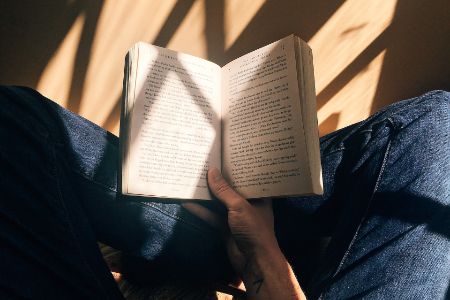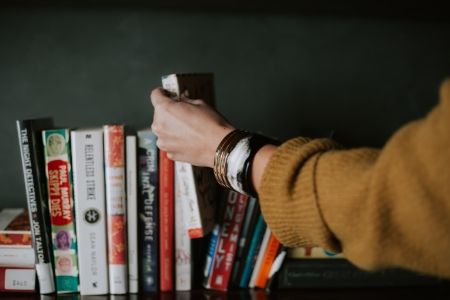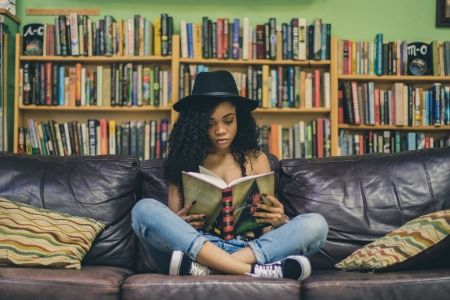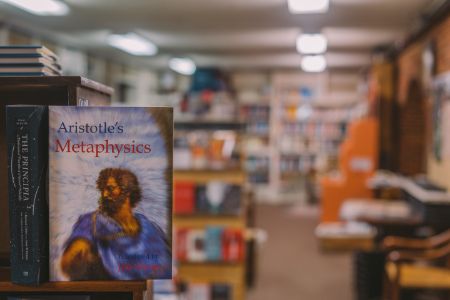How to Read 📖 a Book
How to Read a Book is a guide for reading critically — reading well. The authors differentiate between reading for understanding, information or entertainment. They describe techniques applicable by context … genre, subject matter, author etc. but they don't suggest that it's easy. The prose is sexist (almost as if women don't read) but it delivers a process to learn more than you did by investing in the effort required to read a demanding book.

👌 This post is way too fucking long and needs way more editing — it'll be tidied up when we have some more time. 👌
tl;dr … 🫵
1. How We Learn to Read 🫵
There's a difference between reading for understanding and reading for information or entertainment. How you read makes a difference to acquiring knowledge — there's a difference between knowing and understanding.
Anything easily digested is reading for information or entertainment. A useful heuristic.
This is how most people read anything but they're not really learning anything new. Learning something well enough to understand it requires mental effort. Reading authors who are more knowledgeable on a subject than you narrows the gap between your knowledge and theirs.
2. How You Read Matches Why You’re Reading 🫵
The desideratum of reading determines how you read. Entertainment or informatory reading is different to reading for understanding.
Before you can improve reading skill you need to understand the differences in the reading levels. Each reading level is cumulative and required.
The Four Levels of Reading 🫵
- Elementary Reading
What's taught at early school.
- Inspectional Reading
Skimming and superficial reading e.g., TOC, preface, jacket etc., shows an author’s outline and evaluates if deeper reading is worth the effort.
- Analytical Reading
Some books are to be tasted, others to be swallowed, and some few to be chewed and digested.Francis Bacon.
Analytical reading is reading thoroughly — taking your time and using marginalia to converse with the author.
There are four rules:
- Classify the book according to kind and subject matter.
- State what the whole book is about with the utmost brevity.
- Enumerate major parts in order/relation; outline parts like the whole.
- Define the problem or problems the author is trying to solve.
NB: The inspectional reading already done primes this process because you will understand authorial POV. To understand the subject you do comparative reading to synthesise knowledge from several books on the same subject.
4. Syntopical Reading 🫵
This is also called comparative reading and is the most demanding type of reading — involving the reading of many books on the same subject and comparing different authors' ideas, vocabulary and arguments. Conversation with the questions you ask, the terminology and defined issues is required.
The primary goal is to understand the subject and develop a deep fluency.
This is achieved in five steps:
- Find the relevant passages via inspectional reading of relevant works.
- Unify the terminology used by authors to your own language and use.
- Clarify the questions — focus on the questions you want answered.
- Define the issues — understand multiple perspectives.
- Analyse discussion with authors — allowing an informed opinion.
To Become a Demanding Reader … 🫵
Ask four questions of every book:
- What is the book about?
- What is being said in detail, and how?
- Is this book true in whole or in part?
- What of it?
This is hard work and most people won’t do it. That’s what sets you apart and makes you well read — not the number of books.
The authors see reading's desideratum as the ability to read different texts at appropriate speeds. Quoting Pascal … 'When we read too fast or too slow, we understand nothing', therefore, one should learn how to read related books and grasp their complementary/conflicting elements re the same subject. Doing this in a contextually correct time, makes one a good (demanding) reader.
They're also critical of the average punter's reading prowess …
They can follow a simple piece of fiction and enjoy it. But put them up against a closely written exposition, a carefully and economically stated argument, or a passage requiring critical consideration, and they're at a loss. It has been shown, for instance, that the average punter is amazingly inept at indicating the central thought of a passage, or the levels of emphasis and subordination in an argument or exposition. To all intents and purposes they remain a 12 year old (reader) …
How to Read a Book is divided into parts:
Part One introduces the book's raison d'etre and the different reading levels and details the first Elementary and second Inspectional levels of reading.
Part Two deals with the third reading level — Analytical reading.
Part Three discusses approaches to reading different types of material.
Part Four covers Syntopical reading — the fourth level of reading.
Appendix A covers a Recommended Reading List of great and rewarding books — begin reading these with those of most interest personally.
Appendix B has Exercises And Tests At The Four Levels Of Reading.

PART ONE 🫵
The Dimensions of Reading 🫵
1. The Activity and Art of Reading 🫵
This book is for those whose main goal in reading is to gain increased understanding — to gain a large share of their information about, and understanding of, the world from the written word.
Radio/TV/Web have taken over the functions of print — they're good for communication of news but less good for understanding.
Knowledge is a pre-requisite to understanding but only partially because too many facts can be detrimental to understanding.
Media 'packaging' of intellectual positions and information can make thinking appear unnecessary — making it easier to make up your 'own' mind but really you're just regurgitating someone else’s opinion and information whenever it seems appropriate. This isn't 'critical thinking' it's performing/posturing.
Active Reading
Reading is an activity and therefore should be active — more is better as with catching which is just as active as throwing so writing skill and reading skill converge to make effective communication (it's the ball which is passive).
Reading better is being more active and performing each reading act more skilfully and therefore — successful communication happens when the writers and readers skill converge i.e., message received!
But, a piece of writing is more complex than a ball — the amount caught (understood) depends on reader skill (mental activity) and the amount of activity (their effort).
The Goals of Reading: Information & Understanding
If the material is intelligible — then you already know it cf. a book you have to work on to understand more than you understood before.
So, the art of reading is the process whereby a mind elevates itself by its own operations i.e., going from understanding less to understanding more using the actions that make up the art of reading.
NB: reading something intelligible like a newspaper for information isn't learning. You're not understanding more but rather receiving/remembering more information.
We learn from our 'bettors' — reading more demanding, and therefore more rewarding, material.

Reading as Learning: By Instruction v By Discovery
Again, getting more information is part of learning as is understanding more of what you didn't understand before. But, there's a difference between these two learning types:
i. To be informed is simply knowing what is the case. ii. To be enlightened is also knowing what is it all about: why it's the case, what its connections are with other facts and its differences with those facts etc. — the distinction between remembering something and being able to explain it. The former is gaining information but enlightenment is achieved when you know what is said, what is meant and why the author says it i.e., don't stop at fact-gathering — being informed.
Michel de Montaigne, known for popularising essay as a literary format/genre by merging anecdotes and autobiography with intellectual insight (see his humanism in Essais 1580), was inspired by Plutarch and Lucretius (who's stated goal was to describe humans, with utter frankness) speaks of an …
'Abecedarian' ignorance that precedes knowledge, and a doctoral ignorance that comes after it. The first is the ignorance of those who, not knowing their A-B-C’s, cannot read at all. The second is the ignorance of those who have misread many books.
These bookful blockheads' according to Alexander Pope (18th Century English Enlightenment translator and satirist known for his satirical and discursive poetry, An Essay on Criticism, his translation of Homer, and, after Shakespeare, the second-most quoted in The Oxford Dictionary of Quotations … 'damning with faint praise' … 'to err is human; to forgive, divine' etc.) calls them 'ignorantly read' … 'literate ignoramuses who have read too widely and not well' … 'bookish but poorly read' …
The Greeks had a name for such a mixture of learning and folly which might be applied to the bookish but poorly read … They are all 'sophomores' i.e., 'widely read' does not mean 'well read'.
Learning
By instruction is when one teaches another — learning by discovery comes with research and/or reflection.
Instruction is aided discovery — it's always the student who's learning. The difference being how information and knowledge are communicated (how they're taught) by reading and by listening and learning without a teacher isn't about the discourse, however.
HELP Unaided discovery — reading in context (nature, the world) cf. instruction the art of reading books and (to include listening) learning from discourse.
The art of reading includes the skills of discovery: observation, meaning, imagination and an intellect trained in analysis and reflection.
Present & Absent Teachers
Listening is secondary to reading. A teacher can answer questions but a book can't — only the reader can — therefore learn how to make books teach you well.
2. The Levels of Reading 🫵
The reader's goal — entertainment/information/understanding — determines the way they read. The effectiveness of which is determined by the effort and skill applied. Therefore we must know how to read.
There are four levels of reading and higher levels include the lower levels — they're cumulative.
The First Level — Elementary/Primary School
- Where we first identify words.
- Like learning new languages — what does this word/sentence say?
The Second Level — Inspectional Reading
- Relates to time spent i.e., skimming or pre-reading systematically.
- Determines what a book is about, its structure and parts.
- What type of book is it? Novel, biography, history etc.
- TF read with TOC in mind when reading for understanding.
The Third Level — Analytical Reading
- Complex and Systematic without time limits.
- Actively and thoroughly for the sake of understanding.
The Fourth Level — Syntopcial
- Reading comparatively — subject focussed re multiple As with As with As with As with As with As with As with As with As with As with As with related books.

3. The 1st Level of Reading: Elementary (ER) 🫵
Four Stages of Learning to Read
First Stage: Reading Readiness
- Up to 6-7 years (kindy).
- Physically ready — good sight and sound.
- Language readiness — speaking clearly and using sentences in correct order.
- Personal readiness — the ability to work with other children and sustain attention.
Second Stage: Word Mastery
- Grade 1 literacy.
- Three-four hundred Words.
- Simple books.
- Meaning develops.
Third Stage: Building Vocab through Context
- Grade 4.
- Reading for different purposes/topics.
Fourth Stage: Assimilate all Stages
- Prep school — functional literacy.
- Complex concepts and comparisons.
These four stages are all part of the first level of reading i.e., Elementary Reading.
4. The Second Level of Reading: Inspectional Reading (IR) 🫵
Again, reading levels are cumulative and so Elementary Reading is a pre-requisite. There are two types of IR.
Inspectional Reading I: Systematic Skimming or Pre-Reading.
This strategy shows if a book is worth reading i.e., it requires more careful reading and therefore more time — make it a habit.
Start with title page and preface & read each quickly. Note the subtitles for the book's aim/scope to get an idea of its subject/category.
Then, study the TOC to gleam its structure — as a road map. Read any chapter summaries and check the index to get the range of topics/terms and inspect any links.
Also, read the dust jacket/blurb and inspect pivotal chapters/summaries/end pages.
This system focuses the reader.
Inspectional Reading II: Superficial Reading
Don't despair if material is too hard. The correct approach with this type of reading is to read through 'start to finish' without pause. Concentrate on the parts you understand. This helps second readings (applies to articles also).
Footnotes/references are for 2nd and 3rd readings e.g., Shakespeare — you have to understand enough to learn more.
Reading Speeds
Again, inspectional reading is the art of getting the most out of a text/book in a limited time. Both steps are done quickly but note that many things should be read quickly as they're not worth more time re the nature and complexity of the material. Reading rate is therefore related to the reading goal.
*Interstitial material (e.g., web ads) should be read quickly.
Fixations and Regressions
Use your hand as a 'pointer' swept across a line of typeface slightly faster than is comfortable — practice! This'll help daydreaming/dozing off/concentration i.e., active reading but it's not the basis of comprehension. To comprehend you have to read analytically.
Summary of Inspectional Reading
Reading speed is therefore related to the appropriateness of the material. Skimming/pre-reading lets you know if it's worth reading and, if so, its form and structure. Be intentionally superficial w the first reading.
Importantly, Inspectional Reading anticipates Analytical Reading.
5. How to Be a Demanding Reader 🫵
Make an effort to stay awake (use hand) by reading actively.
You have to do the work …
The Essence of Active Reading: The Four Basic Questions a Reader Asks
To read actively you have to ask questions as you read and answer them:
Question 1: What's the book about as a whole? Discover its theme and how this then is developed through essential subordinate themes/topics.
Question 2: What is being said and how is it said? Discover what ideas/assertions/arguments make up the author's argument.
Question 3: Is the book true — in whole or in part? (can only be answered after Q1. and Q2.) Know your mind — not the authors.
Question 4: What of the book? What's the significance of the information? What are the author's observations/conclusions? Are you informed but not enlightened?
Demanding reading therefore asks and answers questions while reading cf. Un-demanding reading which asks no questions and gives no answers.
These four basic questions apply to anything worth reading. And becomes habit i.e., asking the four questions is what demanding readers do. The art of reading therefore stretches and improves you to new levels with the skill to get there.
How to Make a Book Your Own
The habit of asking questions & giving answers as you read is what makes a better reader. Using a pencil as you go signals alertness.
Marking and writing as you read keeps you awake/alert/active.
Recording your reactions i.e., writing them helps remember what the book says.
Marking a book is therefore a conversation with the author: underlining major points, vertical lines in margin emphasise what's underlined or too long to understand, asterisks emphasise, page numbers assist later access and numbering similar point pages as does Cf. for comparisons.
Structural Note Taking
Is used to ask/answer questions during Inspection Reading: What kind of book? What's it about? What's the structure used to express its ideas? i.e., all 3 questions are largely regarding structure.
Questions marked during Analytical Reading (re truth/significance) are conceptual and you can cf. other books/pages — dialectical note taking.
Forming the Habit of Reading
The art and skill required are based on the habit of operating according to the rules (52) so you learn by doing — practice makes perfect as habit becomes 2nd nature. When these acts have lost their separateness yu have the skill to reach goals.

PART TWO 🫵
The Third Level of Reading: Analytical Reading 🫵
6. Pigeonholing a Book 🫵
The Importance of Classifying Books
Rule #1 of Active Reading is to know what type of book's being read, aqap: fiction, novel, expository (those containing knowledge: opinions, theories or hypothesis) therefore, again, you classify by Inspectional Reading: title, subtitle, TOC, preface, introduction, index, publisher's blurb etc.
What you can Learn from the Title of a Book
The Origin of Species … so know the title! It'll save time and at the end of this early stage you should be able to answer questions about the book — practical v theoretical (practical/prosaic people think 'theoretical' means 'mystical' & therefore is either gospel or bs). You're seeing what is the case as opposed to how to do it.

Kinds of Theoretical Books
History
- The title usually is enough to impart what it's about.
- The essence of history, for example, is narration — what happened and changed over time? Why?
- Is chronotopic (re time/space) — when, where?
Science
- Seeks rules or gernalisations.
- Some itles can be less useful e.g., Newton: Science or Philosophy?
- If outside normal experiernce it's science.
Different Disciplines
- Think and observe but Science is specialised generally.
- Interpret facts differently.
- Narrative is narrative whether fact or fiction; it must be a good story.
- Have different teaching methods — so the relationship between books/reader is similar to relationship between teacher/student.
- Books differ in kinds of knowledge and therefore need to be read in contextual difference.
7. X-Raying a Book 🫵
See a Book's Structure
- What's the book about?
- What's the author's intention?
- How do its parts make up a whole?
- e.g., Odyssey: Aristotle notes the plot — the rest is episode: reduction/decoratiosss;q
Master the Multiplicity: The Act of Outlining a Book
Need to know the parts of the book's sum — its organisation into a comprehensive whole — give account of the structure using an outline; 'does this by doing this ...' e.g., Aquinas' commentary on Aristotle.
What are the book's divisions?
- Outline each, drilling down
- Parts of the parts ... ethics?
- Guide the reading — show how the main theme develops
The author's outline is to write a good book — the reader's is to read it well.
The Reciprocal Art of Reading and Writing
The reader uncovers the skeleton the author covered with argument/information.
Discover authors intentions:
- What was the question they/the books was answering?
- What end does the book serve?
The Final Stage of Analytical Reading
Rules for finding what the book's about:
- Classify according to type and subject matter (95)
- State what the whole book is about w concise brevity
- Enumerate its major parts in order and relation and outline them
- Define the problem the author's trying to solve
8. Coming to Terms with an Author 🫵
The previous four rules tell what the book is about and its structure.
Words v Terms
Communication imparts commonality.
Two minds (R+W) but a word/thought is single i.e., unambiguous. When R+W come to terms, knowledge's been communicated.
- Find important words and come to terms":
- Key words and technical and special words are stressed e.g., bold/italic/underline etc.
- Axioms (self-evident truths) e.g., Euclid.
- Every field has its own tech vocab but some require they be discovered in context e.g., Philosophers use technical terms — words given special meaning. Mark these when reading.
Non-active/undemanding reading is the innatention to words and therefore failure in coming to terms with author.
Finding the Meanings
Is marked word meaningful in different contexts? Are the meanings related? Euclid a point is that that has no part.
Distinguish between author's vocab and terminology e.g., list important words alongside important meanings Xa Xb Xc etc.
A Word in Place is a Term
- Note synomyms and context
- Predicate? Phrase?
Note emotive words used to change minds and not inform/communicate knowledge. (112)
9. Dertimining an Author's Message 🫵
Read, looking for author's propositions/deductions of knowledge — arguing this is bc of that.
Build up from words/phrases to sentences/paragraphs which require interpretation.
Therefore reading's about outlining then deciding arguments/terms. These two approaches make up the contents of the book.
Sentences v Propositions
- Sentences are grammatical units of language.
- Propositions/arguments are logical units of thought and knowledge.
Vocabulary v Terminology
- Context
- Find the important words and come to terms (117, R5)
- Mark major sentences and their propositions (R6)
Locate/construct basic arguments (R7)
- Find key sentences — those not understood completely.
- Read slowly, notice typographical devices
<em>e.g., Euclid's propositions, Aquinas' labels at the start. - Sequential grouping, headings as questions.
Wonder is the beginning of wisdom.
Finding the Propositions
i.e., What does a sentence mean? Modifying words and cluses restrict/amplify meaning? Elucidation is contextual re the surrounding sentences.
The test to know what author means is if you can explain it using synonyms i.e., express their knowledge/thought not just recite their words. Like truely translating another language: 2+2=4 and 4-2=2 means 4 is double of 2 and 2 is half of 4.
Nothing acts except what is actual …
i.e., if something doesn't exist it cannot do anything.
Bank balances don't increase just bc it's possible …
Verbalism is what people who don't read analytically do. they don't get past the words bc they don't know grammar and logic.

Finding the Argument
Rule 7 of Active Reading (127) deals with groups/collections of sentences — paragraphs etc. The argument is made with a sequence of propositions/logical units.
Terms are related to words and phrases; Propositions to sentences — and both make up an argument running through one or more paragraphs.
NB: Not all sentences express arguments — they can detail evidence or methodology and therefore can be read quickly.
Numbers # in margins can tie together the sequence of sentences making up the argument.
Euclid, Gallileo, Newton tended to use single paragraphs to express single argumentative units.
Check Summaries. You know they exist by initial inspection of TOC etc.
Arguments involve a number of statements:
- Inductive statements are the reasons …
- Deductive statements descriminate which is evidence by fact or generalisation …
- e.g., Science does this by reasoning as proof or established by experiement …
- Axioms — assumptions/self evident therefore no proof necessary.
- Give starting points.
Tautological inferences?
- Can be legerdemain … a rabbit being pulled out of a hat to tres surprise may give authenticity but 'a father of a father is a grandfather' Cf. 'The whole is greater than its parts' where its parts are related it's axiomatic/self evident — tautologies don't add to knowledge.
Finding the Solutions
The 8th Rule
- Bring together: terms, propositions and arguments.
- All three, make up the interpretation of a books content.
- Tie together the First Stage of Analytical Reading (outlining the structure) and the Second Stage (interpreting the contents).
- Remember, Rule 4 discovers what the book is about re the problems the author is trying to solve. But, did they succeed?
- Rule 8 finds author's solutions (134).
The Second Stage of Analytical Reading
What is being said and how (details, Rules 5-8) you know the answers when you've come to terms with author, found the key propositions/arguments and identified the solutions to problems faced.
REVIEW
- The Second Stage of Analytical Reading OR Rules for finding what a books says (content inspection).
- Come to terms with author by interpriting key words.
- Group leading propositions by dealing with most important sentences.
- Know as arguments from inspection or construction from out of sequences of sentences.
- Which problems has a solution/failure.
10. Criticising a Book Fairly 🫵
To date, we have learnt how to outline a book and the four Rules for interpreting a book's content. The Third Stage of Analytical Reading is based around a conversation profitable bc something has be learnt.
Criticising a book is part of actively reading it.
Teachability is a Virtue
'Talking back' is the third stage of analytical reading. Including rules of intellectual etiquette:
Read not to contradict and confute; nor to believe and take for granted; nor to find talk and discourse; but to weigh and consider. Francis Bacon.
Sir Walter Scott dumped on those 'who read to doubt or read to scorn'.
Readers must know how to judge a book as they must know how to arrive at an understanding of its contents and the third group of rules for reading is a guide to the last stage of teachability.
The Role of Rhetoric
Be reasonable for having a position — it's yours not the authors. Regarding others as responsible for your judgement is slavery not freedom — such a position is the basis of liberal arts.
Rhetoric is knowing how to convince/persuade. For readers it's knowing how to react to such attempts.
The Importance of Suspending Judgement
Both author's and reader's rhetorical roles are based on grammatical and logical skills. So the ninth rule of reading … you must be able to say you understand before you agree/disagree with the author.
Agreement is also part of critical judgement and therefore suspending judgement = not being convinced. Critics tf need to apply all three stages to a book. They must be able to state an author's position otherwise, they haven't understood.
NB: Understanding Aristotle requires knowldge of his other works. Poetics' analysis of poetry relies on his treatises on psychology, logic and metaphysics. Also applies to Plato, Kand Adam Smith, Marx etc.
The Importance of Avoiding Contentiousness
Is the 2nd maxim of critical reading (144) i.e., disagree reasonably.
Learning truth is always better than winning the argument.
If conversation is a battle you can only win being the antagonist who successfully disagrees i.e., you set out to disgree regardless of the facts and this is emotional not intellectual.
On the Resolution of Disagreements
The 3rd maxim of critical reading is that disgreements can be resolved — otherwise it's hopeless. The relatively ignorant arge with the relatively learned re matters beyond their knowledge.
During disputation, the inequality of knowledge can be cured by instruction. The problem is those who they disagreement is a matter of opinion and not related to being taught/learning something become ping-pong-like because they're satisfied with not losing and nothing changes therefore …
Argue with reasoned statements of knowledge and not flat expressions of opinion.
Rule 11
- Reasons must be given for any critical judgement given.
- i.e., knowledge v personal opinion.
- Opinion is unsupported judgement.
Critical reading therefore consists of:
- Understand first
- Adjure disputateous reading
- View disagreement about knowledge remediable bc you have to give reasons
11. Agreeing or Disagreeing with an Author 🫵
To critique correctly, you must be able to explain the author's why and where.
Reason(s) must be greater than feelings.
i.e., strong feelings/emotions are not enough to argue and you must challenge your own predjudices.
Sine qua non — of good conversation — more light, less heat — impartiality — try and take their POV — criticise don't attack.
If you disagree with the author you're saying 'I understand but disagree because:
I. They're uninformed — you must identify whay they/their argument has missed and show its relevance e.g., Darwin was ignorant of the mechanism of genetic inheritence. Gibbon lacked info re the fall of Rome.
II. If author is misinformed they assert what is not the case e.g., Aristotle was wrong about female elements of reproduction and procreation. Aquinas was wrong about celestial body movement (but doesn't affect his arguments about metaphysical matter and form).
III. That the author is illogical — there's a fallacy of reasoning:
a) Non sequitor i.e., their conclusion does not follow from the reasons provided.
b) Inconsistencies e.g., Machiavelli's The Prince's argument that good laws come from well armed police.
Judging the Author's Completeness
IV. Is the argument complete? i.e., has the book/author solved the problem fully? e.g., Aristotle's Politics is missing universal suffrage etc.
The Stages of Analytical Reading
I. THE FIRST STAGE OF ANALYTICAL READING: RULES FOR FINDING WHAT A BOOK IS ABOUT
- Classify the book according to kind and subject matter.
- State what the whole book is about with the utmost brevity.
- Enumerate its major parts in their order and relation, and outline these parts as you have outlined the whole.
- Define the problem/s the author has tried to solve.
II. THE SECOND STAGE OF ANALYTICAL READING: RULES FOR INTERPRETING A BOOK'S CONTENTS
- Come to terms with the author by interpreting his key words.
- Grasp the author's leading propositions by dealing with his most important sentenc es.
- Know the author's arguments, by finding them in, or constructing them out of, sequences of sentences.
- Determine which of the author's problems are solved, and which they haven't; and of the latter, decide which the author knew they'd failed to solve.
III. THE THIRD STAGE OF ANALYTICAL READING: RULES FOR CRICISING A BOOK AS A COMMUNICATION OF KNOWLEDGE
A. General Maxims of Intellectual Etiquette
- Do not begin criticism until you have completed your outline and your interpretation of the book. (Do not say you agree, disagree, or supend judgement, until you can say 'I get it (understand.)')
- Do not disagree disputatiously or contentiously.
- Demonstrate that you recognise the difference between knowldge and mere prsonal opinion by presenting good reasons for any critical judgment you make.
B. Special Criteria for Points of Criticism
- Show wherein the author is uninformed.
- Show wherein the author is misinformed.
- Show wherein the author is illogical.
- Show wherein the author's analysis or account is incomplete.
NB: Of these last four, the first three are ctieria for disagreement. Failing in all of these, you must agree, at least in part, although you may suspend judgement on the whole, in the light of the last point. (161)
The Third Stage of Analytical Reading (AR)
- The first four rules of AR help answer 'What is book about as a whole?'
- The second four rules answer 'What is being said in details and why?'
- The third stage helps answer: 'Is it true? What of it?'
NB: 'Truth' no longer matters e.g., novelty, controversy, sensationalism (therefore more 'readable') etc. Facts are 'interpreted' to give conclusions — information v. understanding.
If I read as many books as most … I'd be as dull-witted as they are. Thomas Hobbes.
Being well-read is about quality not quantity.
12. Aids to Reading 🫵
Intrinsic Reading
- Reading a book by and in itself without going outside to find its meaning.
Extrinsic Reading
- Reading a book in light of other books/sources/material.
- There are four categories of extrinsic aids to reading:
1. The Role of Relevant Experience
- Common (!= universal) v Personal e.g., books of fiction, philosophy etc. are based on common experience.
- Whereas, science/tech may be special therefore test yourself to see if you've understood the book e.g., Aristotle's Ethics gives egs of a 'virtue':
- The mean between the extremes of defeat & excess.
2. Other Books as Intrinsic Aids
- Having read specific books, sometimes in special order you can compare.
- Read bks the author reads.
3. Commentaries and Abstracts
- Use sparingly/judiciously because some are wrong and can be self limiting.
- Read book's preface and introduction first — commentaries after finishing.
- Abstracts can be reminders of contents (and deciding if it's worth reading).
4. How to Use Reference Books (173)
- Dictionaries, encyclopedias, google …
- Use a reference book well because it can't think for you:
- (1) What is it you want to know?
- (2) Where, in the reference, is that to be found?
- (3) How is the reference material organised? ...
- Read the editor's notes
- Now, it's how to search ... terms/sites/authority ... social media
- Unsupported opinions have no place in reference books ... but do online! (174-5)
- (4) Opinions as to what is knowledgeable have changed. Before, you had to know quite a lot but now 'look it up' is useful to those who know nothing — Google is a guide to the perplexed.

How to Use a Dictionary
- Historically, you had to 'sit at the feet of masters' therefore Romans began education using Greeks and their culture — first dictionaries were Homeric glossaries.
- Dictionaries are extrinsic aids to learning offering details, history etc. re language.
- Help with tech books, literary allusions or obsolete useage, author's vocab.
- Dictionaries are about words not things therefore only need words used in the book you're reading.
Dictionary Reading Rules
-
- Words are physical — writable and speakable therefore need uniform ways of spelling and pronunciation.
-
- Words are parts of speech — context and grammar roles within sentences.
-
- Words are signs with many possible meanings.
-
- Words are conventional with histories/etymologies. They're perfect self-help books because definitions tell what to notice and how to interpret the abbreviations and symbols used therefore consult the explanatory notes and abreviations list at the start.
How to Use an Encyclopedia
Know all the contents and you're an idiot savant … a learned fool.
The Greek term referred to knowledge itself; not a book — all that a learned person should possess.
Romans e.g., Pliny's but not till 1700 was the first alphabetical one produced and strove to contain all knowledge — the seven liberal arts — the trivium: grammar, rhetoric and logic; the quadrium: arithmetic, geomertry, astronomy and music.
Uni and study followed this structure/relationship, now roughly divided into specialites (180) i.e., departments.
therefore Any understanding of encyclopedic facts relates to the other facts/disciplines and recognising their relationships.
Cf. www which removes (by default) these relationships/requirements — the relationships are now technical and subjective rather than intellectual.
Alphabetical encyclopedias obscure these relationships and hilight at the same time with topical organisation which can make it harder for laymen but best would be alphabetical articles with a topical key or outline (tags?) dependent on author/agenda.
A TOC is a topical arrangement of a book Cf. an Index which is an alphabetical ordering.
The web offers the possiblity of both because there's no one editor with a single set of usage instructions and physical enclopedias are awkward to use e.g., Index volumes are required.
- FACTS ARE PROPOSITIONS. Statements of fact employ words in combination: 'X was born 1990.' or 'The atomic number of gold is 79.' To understand but, you must know their significance and how that affects the truth sought using it.
- FACTS ARE TRUE PROPOSITIONS. Facts aren't opinions — they're what is generally agreed to not what a minority 'think' to be the case.
- FACTS ARE REFLECTIONS OF REALITY. Facts may be (a) informational singulars (birth date of X) or (b) relatively unquestioned generalisations (the atomic number of gold). Facts are not ideas or concepts or theories/speculations about reality. The exception would be encyclopedic explorations of things associated with a topic like Qanon in relation to the pandemic.
- FACTS ARE TO SOME EXTENT CONVENTIONAL. Facts may change e.g., scientific and cultural e.g. bc better equipment or religious or regional 'facts'.
Encyclopedias and dictionaries can settle facts but not opinions. Encyclopedias are about facts; dictionaries are about words, but, neither contain imagination or reason.

PART THREE 🫵
Approaches to Different Kinds of Reading Material 🫵
13. How to Read Practical Books 🫵
Analytical Reading applies to expository books — books conveying knowledge (187).
The 15 rules don't apply to fiction or poetry bc outlining that sort of book's structure is different — there're no terms, propositions and arguments — they're not logical. There are, however, the four basic questions asked of any book.
Expository books are Practical or Theoretical — canvassing problems of action or something to be known.
Theoretical books can be divided into science, history, maths and philosophy (look at Practical books later).
The Two Kinds of Practical Books
- Declarative or imperative (implies) types of books.
- Dealing with what can only be solved by action — doing.
- Self-solving
- Present rules or pinciples which generate those rules (overlap): 'A stitch in time, saves nine.'
The Role of Persuasion
So, the two questions for any Practical Book (PB, 193) are:
- What are the author's objectives?
- What means of achievment are proposed?
What does agreement entail with Practical Books?
- What is the book about? An outline of its structure is required as it's an expository work.
- What problems are they trying to solve? i.e., what does author want you to do?
- Discover the terms, propositions and arguments to find a book's meaning/contents.
- Is it true? re personal experience.
- What of it? Does it change your view on the subject? Agreement with a PB implies you act — applying their means — if not, then you don't really agree with it.
14. How to Read Imaginative Literature (IL)
Not being able to say what they liked about a novel probably means they didn't read it deeply. IL pleases more than it teaches.
How not to read IL
- IL and EL (expository) have different purposes.
- Expository books convey knowledge/information intellectually Cf. Imaginative Literature communicating experiences via imagination and senses (200).
- To know something requires intellectual consideration.
Conversely, IL is passive i.e., the book acts on us, using language differently e.g., Dante's comment re Divine Comedy '... read with multiple meanings ...' distinct but related — ambiguous, implied etc., therefore you don't look for terms, propsitions and arguments in IL.
Learning comes from experience produced in our imagination therefore we learn from our own thinking Cf. learning from science etc. where we have to understand author's thinking and experience.
General Rules for Reading Imaginative Literature
- Structural rules of outlining also apply to fiction and become:
- Classify a work of IL to its kind. A lyric tells a story in terms of an emotional experience. Novels and plays are more complicated (characters, plots etc.) with first person narrative etc.
- Grasp the unity of the entire work. The test is if you can express it in 1/2 sentences. An expository work's unity resides in the problem/question it tries to solve
||by the propositions that answer it Cf. the unity of fiction, however, where the problem is the attempt to convey and experience i.e., its plot which must be summarised by brief narration (not a proposition or argument). - Discover how this whole is constructed out its parts (205) i.e., the steps that develop the plot — details of characters and incident — the story arc. Expository book's parts can be read independently.
- Interpretive rules for reading fiction:
- The episodes, incidents, characters — their thoughts, their actions become terms like logical discourse.
- Terms are connected in propositions — become at home in author's imaginatory world.
- The analysing of reason in an expository work is like accepting the narrative.
- Critical rules of reading fiction:
- What the author has tried to make you experience therefore before stating 'likes/dislikes' you must appreciate it actively i.e., passionately by performing elements of analytical reading (AR).
- Objectify your reactions to the work by pointing out what caused them. What's good or bad and why.
Good taste in literature is aquired by those who learn to read.
15. Suggestions for Reading Stories, Plays & Poems 🫵
Re Imaginative Literature, the Four Questions:
- What's the book about as a whole, is answered when you can describe the plot.
- What's being said? in detail and how, is answered when you can discern the role that the various characters play and recount their involvement.
- Is it true or not? and give a reasoned judgement — if it's a likely story.
- Can you say it satisfies heart and mind and why & its beauty?
- What of it? with expository books the answer implies some action — physical/mental agreement, but with IL the answer's different — all you have to do is experience it. As Emerson said of beauty 'its own excuse for being' e.g. re totalitarianism, 1984.
Indecision is a decision
How to Read Stories
Quickly with utter immersion in as short as time as possible — live in the characters' world.
Epics
- Dante Divine Comedy
- Milton Paradise Lost
- Homer
- Virgil
- See prose translations
How to Read Plays
Try directing as you read. Aristophones spoke to his audiences.
Read Shakespeare out loud with emotion/emphasis etc. to try and understand before you look up meaning in notes etc.
A note about tragedy
- Aeschylus, Sophocles, Euripides, Shakespeare, Moliere's comedies.
- It's about running out of time.
- Rushed decisions w tragic consequences
- Buskins on feet therefore giant Cf. chorus
How to Read Lyric Poetry
- Rhyme = poetic diction.
- First stanza = first paragraph.
- Poetry can be re-visited to get different meanings over time.
- Read it through without stopping because good poetry has a unity.
- Read through again but out loud. Speaking it helps/forces understanding — seeing where the emphasis lies. Once apprehended in unity you can start asking questions which the secret of understanding — grammatical and logical questions for expository works with lyrics it's rhetorical or syntactical — discover key words — Shakespeare's sonnets were about love v time.
16. How to Read History 🫵
History
- A written record of the facts re a period of time.
- Facts/truth/what happened are elusive.
- Reasonableness is tempered by subjectivity.
Theories of History
- Making patterns out of facts.
- Tolstoy thought it impossible to really know why anything happened.
- All histories are written from a POV — truth comes via more than one.
The Universal in History
- Thucydides' account is one sided but invaluable.
- From 5th Century BCE he determined what happened after as applied to today.
- tf Universal history repeats mistakes.
- The future is determined by the present to a large extent.
- History is the story of what led up to now.
- History helps learn how people act — cause/effect.
Questions to Ask of a History Book
- Know precisely what the book is about — what it doesn' do.
- Learn historical particulars (236) time-place/people.
- Wider implications i.e., what's the linmited subject/limit set by the author.
- How does author break the story up?
- History books can show the future.
How to Read Biography & Autobiography
- A story about real persons.
- Written as a narrative account of someone's life history — therefore similar to a history book.
- Authorised means definitive — final/exhaustive therefore only about the dead! e.g., Boswell's Life of Johnson.
- Authorised bios are different — may be biased re commission etc.
- Basic bios are without completeness or authorisation Lives by Izak Walton.
- Others can be didactic w moral purpose Plutarch's Lives of the Noble Grecians and Romans.
- Auto biographies can't be true/complete bc still living when written.
- Many books are somewhat autobiographical i.e., about the author.
How to Read About Current Affairs
- Who is writing the report?
- What are they trying to prove?
- Who are they trying to convince?
- What facts are doctrinal?
- What special knowledge is assumed? (245).
- Re predjudice/opinion do they use trigger words?
- What is their motivation?
- With digests — what's been edited out?
How to Read About Science & Mathematics
- Classic and Modern works
- Cf. modern works for laypersons
- Still, what's the problem author's trying to solve?
Suggestions for Reading Classical Scientific Books
- Detect author's presumptions/biases
- What knowledge is assumed?
- The main propositions are expressed as technical terms (general)
Science is inductive — re observable evidence and deductive where arguments are proved by other propositions already established.
Language is a medium of communication on subjects the communicants can mutally understand as long as outside emotional facts and relations. It's whenever we invest in things with emotional communication that we have trouble understanding Cf. maths.
The Problem of Mathematics
- Has its own vocabulary, syntax and grammar which has to be memorised.
- Euclid's Elements of Geometry propositions are of two kinds-
- Statement of the problem in the construction of figures which require something be done — QEF quod erat faciendum (being) 'what is required to do', and
- Theorems about the relations between figures or their parts which require something be proved — QED quod erat demonstatum (being) 'what is required to prove'.
The first three propositions (of five) in Book 1 are probelems of construction — Why constructions are needed in the proofs of the theorems as with the fifth proposition (a theorem) i.e., in an isosceles triangle (w two = sides), the base angles are equal which involves proposition 3, for a shorter line is cut off from a longer line, which depends on the use of proposition 2 construction, while proposition 2 uses proposition 1 and therefore these three constructions (1, 2, 3) are required for proposition 5.
Constructions are also used with prostulates and both assert that geometrical operations can be performed.
This possiblity is assumed with postualtes and proved with propositions (using the postulates) e.g., existence of equalateral triangles (and other maths objects) is assumed by proposition and therefore equalateral triangles exist (256).
With propositoin 5 the theorem re the equality of the base angles of an isosceles triangle. When conclusions are reached re a series of steps referencing previous propositions and postulates, the propostion has been proved and therefore if something is true i.e., that there's an isosceles triangle) and if other things are valid (the definitions, postulates and prior propositions) then the conclusion is too i.e., and if-then relationship, one the proposition proved.
But, ordinary discourse and philosophy etc., doesn't usually limit itself e.g., logic with philosophy therefore not always clear but metaphysical reasoning works: All animals are moral; All men are animals tf All men are moral is assumption based and doubt comes with the uncerttainty of 'truths'.
Handling the Maths in Scientific Books
Can be an obstacle!
- Read Euclid etc., (258)
- Hippocrates on medicine — the art of keeping people well Cf. curing them when sick.
Readers primary obligation is not to become competent in the subject matter but rather — understand the problem.
Popular Science
Is written for wide audiences not just for specialists by reporting the results of experiments rather than the process and have little maths (unless it's about maths).
However, they must be read actively
- Identify the subject matter
- Discover the relation between the whole and its parts
- Understand the propositions and arguments e.g., Whitehead's Intro to Maths, Barry Comer's The Closing Circle — the thing to do in a crises is to act in a certain way or stop acting that way.

18. How To Read Philosophy 🫵
According to Aristotle, philosophy 'begins in wonder' but a mind not agitated by good questions can't appreciate even good answers.
Great philosophical questions are child-like.
The questions philosophers ask have evolved — existence, change, being, material/immaterial, good v evil … there is nothing … thinking makes it so (Hamlet).
Good v evil as concepts … are different, there are orders goods … duties v obligations; vitures v vices; happiness, life's purpose; justice the just polity and economy; war and peace.
Two Main Groups of Philosophical Thought
- First is what is or happens in the world: Theoretical or speculative philosophy.
- Second is good and evil, right and wrong — what ought to be done or sought: Practical or normative philosophy e.g., What type of life to seek? What goals to seek in life in universal terms?
Philosophical questions also differentiate between subordinate branches of the two main types of philosophy:
Works of speculative or theoretical philosophy are metaphysical when concerned with being or existence. (269)
It's a work in the philosphy of nature if concerned with becoming: the nature and kinds of changes, their conditions and causes.
If its primary concern is with knowledge — questions about knowing things with causes and extent and limits of knowledge then its a work of epistemology — the theory of knowledge.
The main distiniction is between questions about the good life and what is right or wrong in indivudual conduct (turning from theoretical to normative philosphy) are re ethics and questions about individual conduct re society are the sphere of political philosophy (politics).
Modern Philosophy & the Great Tradition
There are also several other philosophical questions: questions about first order knowledge, questions about first order thinking, questions about the language used when expressing first order questions. (270)
The modern focus is re second order questions therefore reading before Plato is 'first-order'.
On Philosophical Method
Re first-order thinking/reflecting because there was no scientific method to be done e.g., terrestirial vs celestial bodies — we now know scientifically that all matter is the same.
On Philosophical Style
While there's on one philosophical method there are numerous styles of exposition in the western tradition. (274)
At an introductory level, there's probably only one philosphical method but at least five different expository styles exist in 'Western' philosophy — each with its own proponents, advantages and disadvantages.
- The Philosophical Dialogue
The 'original' and maybe the most effective, coming from Plato's Dialogues where men discuss topics with Socrates or the Athenian Stranger who asks questions and makes comments, thereby leading you to think for yourself.
Plato had no doctrine, he just kept talking and questioning which lead to subsequent philosophers/philosophies …
- The Philosophical Treatise or Essay
This is the major expository style (works seeking to inform), and later adapted by Immanuel Kant, of Aristotle's writing on different subjects. It lead to different branches and approaches of future philosophies.
Most of Aristotle's surviving works are documentary collections — works like: Metaphysics, Ethics, Politics and scientific works on natural history.
Kant's work was very ordered with beginning, middle and end. His philosophical views come from straitforward positions — not the conflict and objections of other positions like Plato.
- The Meeting of Objections
A style from the middle ages and St. Thomas Aquinas' Summa Theologia. Plato raises questions; Aristotle replies to objections; Aquinas does both — usually finishing with scripture and 'I answer that … '.
So-called Thomistic philosophy lead to debate and discussion in the intellectual market place.
- The Systemisation of Philosophy
An expository style developed by Descartes and Spinoza and organised mathematically as with the structure and certainty of Euclid's geometry. Spinoza went further with Ethics also in mathematical form: propositions, proofs, corollories, lemmas, scholiums etc.
Not successful Cf. Galileo failing to wrap scientific work in dialogue form.
- The Aphoristic Style
From Nietzche's Thus Spake Zorathustra and more modern French philosophers copying books of 'Eastern' wisdom texts. Some say it's a shallow style made up, effectively, of 'sound bites'.
The most successful styles today are the Treatise and Essay but all major philosophers have used styles 1-3 at least.
How to Read Philosophy
The primary point is what question is the philosophy book trying to answer? As with any author, the better the philosopher; the better the question, e.g., Plato's The Seventh Letter thought conversation about philosophical subjects was the most important human activity and Socrates' Apology said the 'unexamined life is not worth living'.
Also, Aristotelean works assume things said in other works as being relevant to the discussion e.g., the basic principles of logic in the Organon are presumed in the Physics or where 'happiness' is viewed from all the aspects of an entire life i.e., he has his 'shit together'. Or Kant's limitation of the mind explicitly stated in Critique of Pure Reason is assumed in the Critique of Judgement.
Kant's 'critical philosophy' contrasted criticism to dogmatism so 'pure thought' was dogmatic and there was more to the mind's finite resources. So avoid their biographies and come to your conclusion as to their controlling principles.
Because, reading any philosopher, you have to decide if they're consistent, themselves. Principles or conclusions? Is the latter's invalid if they don't follow them?
Reding philosophical works als differentiates between philosophy and science — theoretical books about life metaphysics or treatises abou the philosophy of nature i.e., explain not describe (like science). All 'answers' require clear arguments and analysis therefore don't assume common words (in these works) have the same common meanings.
Abstractions are generalisations — anything taken in by the senses is concrete — what you think is abstract and general. So, you need to learn the philosopher's principles (never said this was easy!).
Try 'believing' … something you don't.
The rules of reading and our imagination are more applicable to philosophy books than to other types.
On Making Up Your Own Mind
Listen to what other philosophers have to say on the same subject. What's true / false? Reading well means you can (285) judge their arguments.
Taking the opinions of others doesn't solve rt, rather, evades problems therefore you always have to back up with an argument — unlike science, you can't take their word for it.
A Note on Theology
There are two types: Natural and Dogmatic. Natural is a branch of philosophy related to metaphysics — so an *originating cause that is not itself caused (what Aristotle called 'the unmoved mover') is concluded/discovered with your own thoughts.
Cf. Dogmatic theology being different to philosophy because its first articles are of religious faith. For such fuckwits this is certain knowledge not an opinion therefore when reading this nonesense temporarily suspend disbelief.
How to Read Canonical Books
Bible, Marx, Mao etc., are read reverentially by believers e.g., Army Infantry Manual — all read in an orthodox manner (from the Greek 'right opinion').
9. How to Read Social Sciences 🫵
Concepts and terminology prevade newspapers, commentary and reading material — social criticism — even in fiction featuring artificial social models — metaphors and analogies — film and TV.
What is Social Science?
Anthropology, economics, politics, sociology Cf. law, education, business and commerce therefore get interdisciplinary studies for things like reports and related methodology re cultural, institutional and environmental facts (291) and sometimes history and psychology etc.
The Apparent Ease of Reading Social Sciences
The language is commonly used e.g., society and social are also adjectives.
Difficulties in Reading Social Science
Personal views/points can affect reading — they should be 'left at the door' — analytical reading is objective.
There's also carelessness with terminology like 'GDP' bandied about without an exact understanding/explanation. (295) Although, some authors stipulate usage with definitions, postulates and axioms but, even then, the terminology can be confusing.
History, for example, is a mix of fiction and science therefore read it with that in mind. Social science is a mix of science, philosophy, history and fiction too.
All this varies by author.
Reading Social Science Literature
Requires the high level of syntopical reading leading to this, practical books need action Cf. fiction and poetry (non-expository) Cf., three types of theoretical (expository) writing: science and maths, philosophy and social science.

PART FOUR 🫵
The Ultimate Goals of Reading 🫵
20. The Fourth Level of Reading : Syntopical Reading 🫵
Choosing the right next book to read on the same topic and knowing that more reading is required, is the basis of syntopical readings.
The love literature described is silly.
Knowing that another person is admirable precedes loving adoring them (304).
The Role of Inspection in Syntopical Reading
The levels of reading are cumumlative with each including the levels below, so the two steps of Inspectional Reading (skimming and superficial) anticipate the first two steps of analytical reading i.e., where you identify the subject matter, state what kind of book it is and outline its structure.
Superficial Reading prepares for coming to terms with the author stating their propositions and following their arguments.
So, Inspectional Reading and Analytical Reading are preparations for Syntopical Reading. But doing both fully is too time consuming therefore on a particular topic compile a bibliography and apply apply Inspectional Reading to (1) give basics of atopic so as to inform subsequent Analytical Reading and (2) reduce the bibliography to a manageable size and then read read some of those listed faster than others.
Analytical Reading is about understanding that book. Cf. (308) the five steps of SR.
The Five Steps in Syntopical Reading
At this point, you've inspected a number of books and have a good idea of the subject that they're about and it's the subject you're interested in.
STEP 1 IN SYNTOPICAL READING: FINDING THE RELEVANT PASSAGES.
Search for what you're after i.e., germane to your interests, the relevant passages and read them quickly in your context — don't forget that it's what you can get from the book regardless of the author's intentions.
STEP 2 IN SYNTOPICAL READING: BRINGING THE AUTHORS TO TERMS
In the 2nd stage of Active Reading — interpretive reading - the first rule requires that you come to terms with the auther i.e., their key words and use of them. But, with Syntopical Reading you must establish the terms and use because there are numerous authors i.e., overreaching terms that cover all authors therefore Syntopical Reading is translation of sorts from all of them to us (311) in order to solve our problem.
STEP 3 IN SYNTOPICAL READING: GETTING THE QUESTIONS CLEAR
The 2nd rule of interpretive reading requires we find the author's key sentences and from them develop an understanding of their propositions — made up of terms re our search, neutral propositions — by framing a set of questions to highlight our problem within each author's implicit or explicit answers.
The first questions are about the existence/character of what we're investigating through to final questions re how something is known or manifests itself and the consequences re previous questions and answers …
STEP 4 IN SYNTOPICAL READING: DEFINING THE ISSUES
Readers may have to accept an author gives no answers to our questions, although it could just be implicit — questions about the character of what we're investigating.
An issue is defined if an author's question is clear. Pros and cons — questions about the character of the idea considered may generate connected issues therefore controversy.
STEP 5 IN SYNTOPICAL READING: ANALYSING THE DISCUSSION
To this point: we have found the relevant passages in the works being examined, created a neutral terminology that applies to most authors, framed and ordered a set of questions most have answered and defined and arranged the issues produced by different answers.
These four steps correspond to the first two groups of rules for Analytical reading which let us answer that it says and how it says it.
In syntopical reading, we can answer questions about the discussion of the problem Cf. Analytical reading: Is it true? What of it? It's the ordered discussion that reveals the answers i.e., via analysing the discussion may lead to a breakthrough.
The Need for Objectivity
Analysis of the discussion of a problem or subject matter defines and reports the major issues or intellectual oppositions in that discussion. Opposition is rarely solitary. The aim of syntopical reading is not the questions that are developed or the solutions to the problem i.e., objective opinion != syntopical reading dialectical objectivity i.e., syntopical reading looks at all sides and tries to take no sides (not 100% possible).
All this requires re-reading of the text to coninually interpret what the author is saying.
An Example of an Exercise in Syntopical Reading: The Idea of Progress
Not really …
The Synopticon and How to Use It
The paradox of synoptic reading is if you don't know the books to read you can't read (them) syntopically, but unless you read syntopically you don't know what to read. Plus, the time to read to find out (what to read) is prohibitive.
Therefore, you require references e.g., The Synopticon. Great Books of the Western World. However it only convers one area (the 'west'). But it's a place to start as it edits them to help us find relevance.
Starting with select passages, you can read more to explore more context … and other authors. It acts instructively also — firstly with the topic/category of the passage offered gives direction to interpretation which leads to discovery of its relevancy.
Secondly, multiple examples enhance understanding of each passage by contrast, comparison and comment.
Thirdly, is syntopical reading applied to multiple texts on multiple subjects having an instructive effect (re the same passage).
On the Principles that Underline Syntopical Reading
Summary of Syntopical Reading
There are two main stages … one is preparatory, the other syntopical reading proper. (326)
I. SURVEYING THE FIELD PREPARATORY TO SYNCTOPICAL READING
- Create a tentative bibliography of your subject re search
- Inspect all the listed books to ascertain which are germane to your subject and refine understanding of it.
nb: #2 modifies #1 usually & vice versa.
II. SYNTOPICAL READING OF THE BIBLIOGRAPHY AMASSED IN STAGE 1
- Inspect the books already identifies as relevant to subject in stage I to find relevant passages.
- Bring authors to terms by constructing a neutral terminology for all authors.
- Establish neutral propositions for all authors by framing a set of questions that all authors answer.
- Define the issues both major and minor using opposing answers.
- Analyse the discussion nb: (*)dialectical detachment should be maintained.
(*) relating to the logical discussion of (usually opposing) ideas and opinions.
21. Reading and the Growth of the Mind 🫵
The more active, the better the reading is. This is done by asking questions and answering them for any book.
There are four levels to reading well — cumulative with active and styntopical reading the most important.
What Good Books can Do for Us
You have to read books that are beyond/above you to grow — they must be demanding: come to terms, identify key propositions and state the main arguments.
There are two kinds of reward with this full reading. First, it improves your reading skill and, second, it teaches about you (what you're capable of doing/understanding) and the world. (332)
The Pyramid of Books
Read non-demanding books by skimming Cf. books which are notable (literally) . Only top-tier books require re-reading. You grow with a great book as you get more out of it.
The Life and Growth of the Mind
Desert island test — which 10 books would you be left alone with? The mind may atrophy like muscles if unused.
APPENDIX A 🫵
A Recommended Reading List of great and rewarding books — begin with those of most interest personally.
APPENDIX B 🫵
EXERCISES AND TESTS AT THE FOUR LEVELS OF READING 🫵
This Appendix has reading exercises and test questions for study — at each of the four levels of reading:
At the First Level of Reading — Elementary Reading: the texts used are biographical notes about two of the authors included in Great Books of the Western World, John Stuart Mill and Sir Isaac Newton.
At the Second Level of Reading — Inspectional Reading: the texts are the tables of contents (TOC) of two works included in Great Books of the Western World, Dante’s Divine Comedy and Darwin’s The Origin of Species.
At the Third Level of Reading — Analytical Reading: the text used is How to Read a Book itself.
At the Fourth Level of Reading — Syntopical Reading: the texts used are selected passages from two other works included in Great Books of the Western World, Aristotle’s Politics and Rousseau’s The Social Contract.
As a test example …
At the first level of reading, speed is not of the essence. The sketch of Mill’s life that follows is about 1,200 words long. We suggest that it be read at a comfortable speed—in perhaps six to ten minutes. We also suggest that you mark phrases and sentences in the text that especially interest you and perhaps also make a few notes. Then try to answer the questions we have appended …
- ↜ Previous: The C🪨al-ition
- ↝ Next: Child Killer Samuel William Davidson